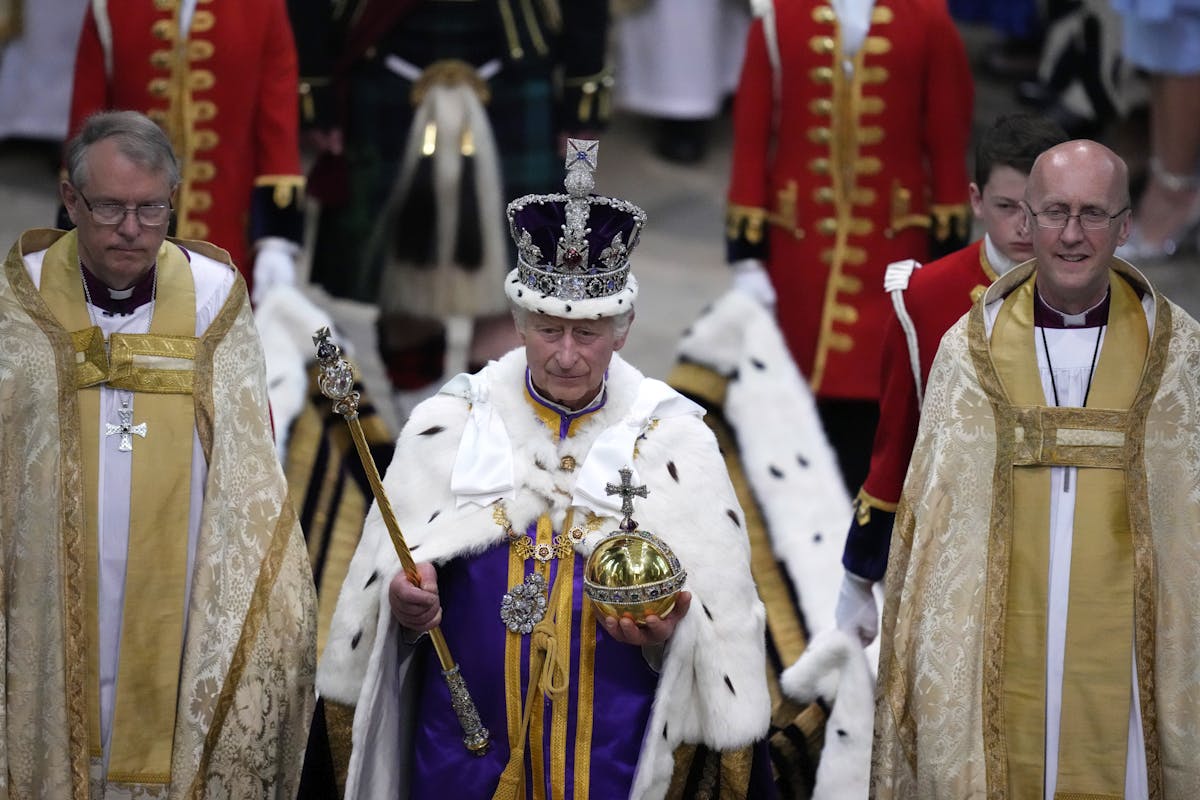King Charles III, Crowned and Anointed, Opens a New Carolean Age
Having waited longer than any other, he is the newest sovereign in a monarchy that stretches back a millennium, and vows ‘I come not to be served, but to serve.’

The crowning of King Charles III, among rain drops and pomp and circumstances, inaugurates a new Carolean age and a fresh chapter for the House of Windsor. Nobody has waited longer for the throne, and few queens have had a more twisting path to it than Camilla Parker Bowles. Now, the realm is theirs.
The ancient ceremony began when King Charles and the Queen Consort left Buckingham Palace in a Diamond Jubilee Coach, all black and aureate. Camilla wore the robe of her mother in law, Elizabeth II, and Charles that of George VI.
Charles accedes to the throne as the first divorced king since Henry VIII, who broke with Rome and created the Church of England of which King Charles is the Supreme Governor. The first king crowned at Westminster Abbey was William the Conqueror, who came from Normandy in 1066 — and all that.
At the abbey, King Charles sat on the Coronation Chair which was commissioned by King Edward I of England — also known as “Edward Longshanks” and the “Hammer of the Scots” — to accompany the Stone of Destiny. The chair and stone have seen the crowning of 26 monarchs since King Edward II acceded to the throne in 1307.
On King Charles’s head rest a crown three and a half centuries old wrought of gold and adorned with ruby, amethyst, sapphire, garnet, topaz, and tourmaline. In his right hand was the Sovereign’s Orb, from 1661. Atop the Sovereign’s Scepter rests a 530-carat diamond. His forehead was dabbled with holy oil.
Notwithstanding the grandeur, King Charles announced upon his arrival at Westminster that “I come not to be served, but to serve.” The service was punctuated by cries of “God Save King Charles” and, intoned in Welsh, the “Coronation Kyri.”
King Charles was presented with a Bible, described to him as “the most valuable thing this world has to offer” and containing the messages of the “lively oracles of God.” He swore the Coronation Oath, promising to “cause law and justice and mercy to be executed” and to “maintain the Protestant Reformed Religion.”
Prime Minister Sunak read from the Epistle to the Colossians, which ordains that “For this reason, since the day we heard about you, we have not stopped praying for you. We continually ask God to fill you with the knowledge of his will through all the wisdom and understanding that the Spirit gives.”
Another reading, from the Gospel of Luke, related how Jesus read the Book of Isaiah at a synagogue in Galilee, telling the assembled that “Today this Scripture has been fulfilled in your ears.” A churchman asked God to bless “Thy servant, Charles thy king.”
The Archbishop of Canterbury, in his sermon, told those lucky enough to get a seat at Westminster that “we are here to crown a king.” He noted that the Christian savior’s “regalia was his wounds.” Reflecting the range of the kingdom, a choir sang “Veni Creator” in English, Welsh, Scots Gaelic, and Irish Gaelic.
The only part of the service that was not visible to all was the anointment itself, during which screens surrounded the kneeling King as he was daubed with holy oil from the Mount of Olives at Jerusalem. This was done to the strains of “Zadok the Priest” from Handel’s first Coronation Anthem, “Zadok the Priest, and Nathan the Prophet anointed Solomon King And all the people rejoiced.” Then “God Save the King,” and a chorus of Hallelujahs.
King Charles received a pair of spurs originally crafted in 1661, when his namesake, Charles II, returned to power after his father, Charles I, lost his head to the Republican forces of Oliver Cromwell. The Sword of State, made in 1678 and adorned with the Tudor Rose, was presented to convey “not might, but mercy.”
After the crowning of the 40th monarch to be invested at Westminster Abbey since the Conqueror, the Archbishop of Canterbury, Justin Welby, and Prince William both knelt and swore loyalty to the King, with the monarch’s son adding a kiss on the cheek. The assembled crowd expressed the hope that Charles would “live forever.”
It was Queen Camilla’s turn next. She too was crowned by the Archbishop, and touched her royal fingers to the regal rod and scepter. After her crowning, the choir sang a new “Coronation Anthem” composed by Andrew Lloyd Webber, a setting of Psalm 98. The Eucharist was celebrated, the Lord’s Prayer intoned, and the “Te Deum,” composed for the coronation of Queen Elizabeth II in 1953, sung.
King Charles, who waited longer than any heir to the throne, strode out from the Abbey with diamonds glittering and robe flowing. He was empurpled from head to toe. With Princes Andrew and Harry visible, barely, in the crowd and millions watching, he rode off to commence his reign with Queen Camilla beside him, the redemption of what has to be seen as a true love match.
In a nod to the woman who would have been queen on the part of one who likely will be named one at the next coronation, the Princess of Wales, Catherine Middleton, wore diamond and pearl earrings that once belonged to Princess Diana.

